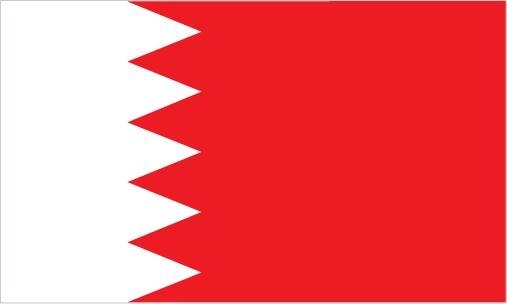129 Bahrain

Red, the traditional color for flags of Persian Gulf states, with a white serrated band.
Five white points representing the 5 pillars of Islam on the hoist side.
Flag courtesy of the CIA World Factbook

Map courtesy of the CIA World Factbook

The Durrat Al Bahrain complex is featured in this image photographed from the International Space Station. Set at the southern end of Bahrain Island, at the furthest point from the cities of the kingdom, is this complex of 15 artificial islands designed for residential living and tourism with luxury hotels and shopping malls. Aimed at a cosmopolitan clientele, the Durrat Al Bahrain includes 21 sq km (8 sq mi) of new land for more than 1,000 residences that has been designed as The Islands (six crescent-shaped “atolls” leading off five fish-shaped “petals”). The Crescent at the bottom of the ring is the heart of the complex and features shops, restaurants, hotels, apartments, offices, and schools. The Central Island is dedicated to one, ultra-luxurious hotel. The three, thick, crescent-shaped islands at the lower left make up the Durrat Marina; the area between the Marina and the Crescent is a golf course.
Photo courtesy of the CIA World Factbook
Government
According to Britannica, since the 18th century, the head of the Āl Khalīfah, the country’s ruling family, has taken the title emir. The constitution promulgated in 2002 established Bahrain as a constitutional hereditary monarchy whose head of state is now titled king. Under the new constitution the executive is composed of a prime minister, who is head of government, and a Council of Ministers, all of whom are appointed by the king. The legislative branch consists of two houses: a 40-member Consultative Council that is also appointed by the king and a 40-member Chamber of Deputies that is elected by universal adult suffrage. Members of both deliberative bodies serve terms of four years. An earlier constitution (1973) created a National Assembly composed of appointed members and others elected by popular vote, but after a period of labour unrest and political agitation the assembly was dissolved by the emir in 1975. Public representation thereupon reverted to the traditional Arab and Islamic system of a majlis (council), through which citizens and other residents presented petitions directly to the emir. In 1993 the emir created the Consultative Council, to which the first women were appointed in 2000.
Bahrain’s legal system is based on Islamic law (Sharīʿah) and English common law. The highest court in the country is the High Civil Appeals Court, and there are separate courts for members of Sunni and Shiʿi sects. When the royal family faced growing unrest in the 1990s from protesters, predominantly Shiʿi Muslims calling for a restoration of the constitution, a special court was established to prosecute dissenters.
Civil Aviation Affairs (CAA)
The Civil Aviation Affairs (CAA) is responsible for developing and regulating the Kingdom of Bahrain’s aviation industry. The CAA regulates and issues air transportation and navigation, airworthiness, and other technical directives that apply to all aircraft flying into or out of the Kingdom of Bahrain. As part of its regulatory role, the CAA also serves as the governing body for setting laws and regulations related to aviation issues and is responsible for ensuring that all stakeholders comply and commit to all regulations and meet obligations. The CAA also assumes responsibility for the issuing of licenses /permits and certification for various activities including aircraft registration, personnel licenses, aircraft operations, and airline schedules. The CAA is also responsible for providing meteorological services including weather reports and forecasts as well as meteorological information.
Airspace
SkyVector – Google Maps – ADS-B Exchange
ICAO countries publish an Aeronautical Information Publication (AIP). This document is divided into three parts: General (GEN), En Route (ENR) and Aerodromes (AD). ENR 1.4 details the types of airspace classes they chose to adopt from classes A through G.
Drone Regulations
Drones – unmanned aerial vehicles (UAVs)
Advanced Air Mobility (AAM) Regulations & Policies
None found by the author.
However, should you, the reader, happen to stumble across something to the contrary, please email the author at FISHE5CA@erau.edu and you may be mentioned in the ACKNOWLEDGEMENTS section of this book by way of thanks for contributing to this free eBook!
Advanced Air Mobility (AAM) News
None found by the author.
However, should you, the reader, happen to stumble across something to the contrary, please email the author at FISHE5CA@erau.edu and you may be mentioned in the ACKNOWLEDGEMENTS section of this book by way of thanks for contributing to this free eBook!
Short Essay Questions
Scenario-Based Question
You have been hired by a Drone Startup Company. Your boss has immediately assigned this job to you.
They need you to prepare a one-page memo detailing the legalities of using a drone to film the coast in Bahrain, pictured above.
They need you to mention any national laws and local ordinances.
They specifically want to know what airspace (insert pictures) you will be operating in and whether or not you need an airspace authorization.
Does it matter whether or not you are a citizen of the country?
Lastly, there is a bonus for you if, as you scroll through this chapter, you find any typos or broken links!
Short Essay Questions
- What are the drone categories?
- How is registration addressed?
- How is remote ID addressed?
- What are the model aircraft rules?
- What are the commercial drone rules?
- Are there waivers or exemptions to the rules? If so, for what?
- Would you share a link to an interactive airspace map?
- How is BVLOS addressed?
- How can you fly drones at night?
- How can you fly drones over people?
- Where do you find drone NOTAMs?
- What are the rules for drone maintenance?
- What are the rules for an SMS program?
- What are some unique rules not mentioned above?
- What are the C-UAS rules?
- What are the AAM rules?

